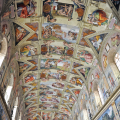CAPPELLA SISTINA
The most famous of the wonders of the Vatican museums, especially for the splendid frescoes by Michelangelo that decorate its vault.
The Sistine Chapel is one of the most visited areas of the Vatican Museums. How to speak, how to describe this chapel? Looking at it and trying to decipher it seems to be the best way. Even if the time to visit is limited, take the time to admire its architecture and, especially, its incredible vault. The chapel is a very large rectangle (40 m by 13 m), with a very high vault (21 m) and no architectural ornaments, no choir, no side chapels, no transept. Nothing distracts the eye from the world-famous pictorial decoration. Built by order of Sixtus IV, from 1475 to 1481, the chapel was part of the palace's defensive system. This is why its twelve windows are so small and high up. The decoration of the chapel was executed in three stages: the cycle of Sixtus IV on the side walls, the vault commissioned by Julius II from Michelangelo and the famous Last Judgment by the same Michelangelo, commissioned by Paul III.
The life of Moses and the life of Christ. They cover the side walls. The original decorative scheme consisted of a series of frescoed frames, placed halfway up so that they could be seen, unfolding on the south side the story of Moses, the central figure of the Old Testament and herald of the covenant between God and man; on the north side, the cycle of Christ who fulfills this covenant. Above, between the windows, the portraits of the first popes. Some of these works have disappeared to make room for the Last Judgment. Sixtus IV called upon the greatest artists of his time. Michelangelo's work is so impressive that one is tempted to ignore the rest, and that would be a pity. The Moses cycle is particularly noteworthy: the first frame from the Last Judgment, which Perugino, Rosselli, Ghirlandaio and Rosselli worked on(Journey to Egypt), Botticelli's second and fifth(Youth of Moses and Punishment of Korah, Dathan and Abiron); in the Christ cycle, the first painting by Pinturicchio and Perugino(Baptism of Christ), the second by Botticelli(Healing of the Leper and Temptation of Christ), the third by Ghirlandaio(Vocation of Peter and Andrew) and the fifth by Perugino(Christ Handing over the Keys to Saint Peter). The paintings that are not mentioned are by Cosimo Roselli.
The vault. It was made by Michelangelo between 1508 and 1512. Pope Julius II, known for his authoritarianism, left Michelangelo free to treat this space according to his inspiration. The six side windows determine nine spaces on the vault dedicated to the story of the creation of the world. Starting from the choir, i.e., the wall where the Last Judgment is located, one can recognize: The Separation of Light from Darkness, The Creation of the Sun and the Earth, The Creation of Plants, The Creation of Man, which is the best known painting of the whole, The Creation of Woman, Original Sin, The Banishment from Paradise, The Sacrifice of Noah, The Flood, The Drunkenness of Noah. Between each scene, Michelangelo painted naked men, the famous Ignudi, which are, of course, a tribute to creation, but also a quasi-sculptural expression that tells us perhaps the regret of the artist to no longer practice his favorite art. The four corner vaults are dedicated to four episodes from the Bible: Judith and Holofernes, David and Goliath, The Supplication of Aman and The Brazen Serpent. Finally, between the windows, the prophets Jeremiah, Ezechiel, Joel, Zechariah, Isaiah, Daniel and Jonah are represented. And, between the prophets, female characters: the Sibyls. These characters, which existed in pagan religions and were supposed to emit the messages of the divinities without their knowledge, have been recovered in the Christian religion as a kind of prophetic auxiliary. An architectural decoration in trompe l'oeil separates these different elements. The whole has been restored and cleaned, a few years ago, which has given back to the colors a forgotten freshness. Some nostalgic people complain about it.
The Last Judgment. The world has changed, and so has Michelangelo. He worked on the Last Judgment between 1534 and 1544 and finished it at the age of 69. But the Reformation also broke up Christianity, and Rome was sacked in 1527. The popes wore beards as a sign of penitence, the Counter-Reformation was underway. Paul III decides to strike the imagination with an evocation of sin and salvation. Michelangelo himself is a tormented being. His poems of the time, for he was a great poet of his time, express this painful feeling wonderfully. A violent work, the Last Judgment caused a scandal. It was spoken of as the Dies Irae of the counter-reformist Church. The nudity of the figures was so shocking that later Paul IV had certain parts of it covered by Daniele da Volterra, who earned the nickname of Braghettone, which is easily translated. It is also said that Michelangelo painted his personal enemy, the pope's master of ceremonies, Biagio da Cesena, among the damned, as Midas, with donkey's ears (bottom right, embraced by a snake). These anecdotes are of little interest when compared to the work, which has just been cleaned, restored and freed from prudish additions. Let us remind you, if necessary, that photos are of course forbidden. The great frequentation of the chapel attenuates a little its magic side, certainly, but the place is always impressive of beauty.
Did you know? This review was written by our professional authors.
Members' reviews on CAPPELLA SISTINA
The ratings and reviews below reflect the subjective opinions of members and not the opinion of The Little Witty.




